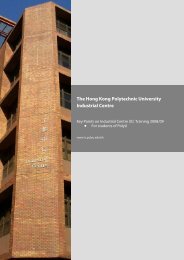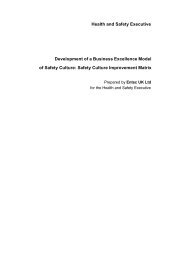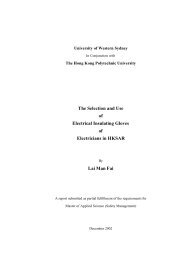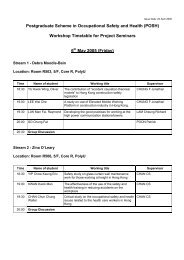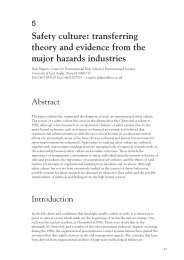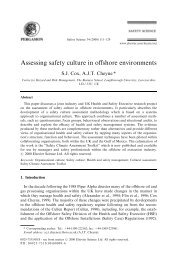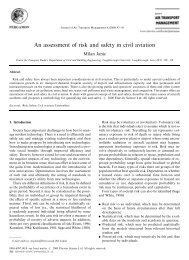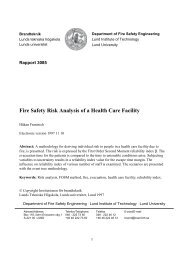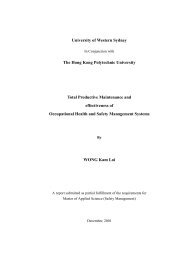Driving Organizational Change in the Midst of Crisis
Driving Organizational Change in the Midst of Crisis
Driving Organizational Change in the Midst of Crisis
- No tags were found...
You also want an ePaper? Increase the reach of your titles
YUMPU automatically turns print PDFs into web optimized ePapers that Google loves.
and <strong>the</strong> responses to <strong>in</strong>dividual compla<strong>in</strong>ts filed with <strong>the</strong>employee-concerns program. The learn<strong>in</strong>g was not <strong>in</strong> <strong>the</strong> policyand <strong>the</strong> structures but <strong>in</strong> <strong>the</strong> behaviors that made <strong>the</strong> structurescome to life. The safety-conscious work-environment conceptbecame part <strong>of</strong> senior managers’ personal learn<strong>in</strong>g.Dur<strong>in</strong>g our <strong>in</strong>terviews, <strong>the</strong> <strong>the</strong>me arose repeatedly that work<strong>in</strong>gon change changed everyone. People became what <strong>the</strong>yneeded to be. They found support <strong>in</strong> a system that encouraged<strong>the</strong>m to acknowledge problems and work toge<strong>the</strong>r. The challengeschanged both managers and employees. Skeptical employeeswatched to see how management reacted to def<strong>in</strong><strong>in</strong>g moments;<strong>the</strong>y weighed <strong>the</strong> differences between words and deeds, betweenpaper promises and real change. Their evaluations would determ<strong>in</strong>eMillstone’s success or failure. The <strong>in</strong>itial tests were necessarynear-failures, but management admitted its mistakes, kept <strong>the</strong>l<strong>in</strong>es <strong>of</strong> communication open, sought lessons for improvementand help from more participants, and tried aga<strong>in</strong>. Over time, peoplelearned to deal with chronic problems, and <strong>the</strong>y learned <strong>the</strong>ywere capable <strong>of</strong> change and that change was welcome.New Ways <strong>of</strong> Th<strong>in</strong>k<strong>in</strong>g About People Much <strong>of</strong> <strong>the</strong> learn<strong>in</strong>g atMillstone required a new sensitivity toward emotions, perceptionsand relationships. Like many <strong>in</strong>dustries, nuclear powerattracts and rewards people who have technical skills and getth<strong>in</strong>gs done — who are objective and leave <strong>the</strong>ir feel<strong>in</strong>gs outside.Few Millstone managers understood how <strong>the</strong>y had lost <strong>the</strong>trust <strong>of</strong> <strong>the</strong> work force or what would be needed to br<strong>in</strong>g heal<strong>in</strong>g.With help from outside consultants and <strong>in</strong>siders with some<strong>of</strong> <strong>the</strong> requisite skills, managers learned that guess<strong>in</strong>g what peopleth<strong>in</strong>k by pretend<strong>in</strong>g to be <strong>in</strong> <strong>the</strong>ir shoes is less effective thangett<strong>in</strong>g people to express <strong>the</strong>mselves. When <strong>the</strong>y express <strong>the</strong>mselvesand get a respectful reception, <strong>the</strong> result is communicationand heal<strong>in</strong>g. Employees must have a reason to believe thatmanagement wants to listen, wants to respond appropriately,respects employees’ suggestions and has <strong>the</strong> competence to succeed.The most powerful way to rega<strong>in</strong> trust is to work toge<strong>the</strong>rwith a common purpose. 21The journey is not over. Millstone, like <strong>the</strong> rest <strong>of</strong> <strong>the</strong>nuclear-power <strong>in</strong>dustry, faces serious challenges. Past mistrustand feel<strong>in</strong>gs <strong>of</strong> anger and hurt can be stirred up by new situations.The work environment and <strong>the</strong> performance successesare fragile, and many people have given about all <strong>the</strong>y can.There will be crises to be avoided and crises to be used to mobilizeenergy for change. Many <strong>in</strong>dustries face challenges <strong>of</strong> rapidchange, ambiguous <strong>in</strong>ternal and external signals, alienation andmistrust, and dysfunctional human relationships. But people <strong>in</strong>all work sett<strong>in</strong>gs can learn from <strong>the</strong> journey out <strong>of</strong> crisis, a journeythat, like learn<strong>in</strong>g itself, never ends.ACKNOWLEDGMENTSThe authors are grateful for <strong>the</strong> cooperation and candor <strong>of</strong> Bruce Kenyon and <strong>the</strong>o<strong>the</strong>r <strong>in</strong>terviewees, who understood <strong>the</strong> importance <strong>of</strong> shar<strong>in</strong>g Millstone’s lessons.The research was supported by a Marv<strong>in</strong> Bower Fellowship at <strong>the</strong> HarvardBus<strong>in</strong>ess School.ADDITIONAL RESOURCESEd Sche<strong>in</strong>’s 1999 book “The Corporate Culture Survival Guide” (from Jossey-Bass <strong>in</strong>San Francisco) <strong>of</strong>fers thoughtful and practical advice. Two <strong>in</strong>terest<strong>in</strong>g examples <strong>of</strong>senior managers reshap<strong>in</strong>g <strong>the</strong>ir companies are seen <strong>in</strong> David Kearns and DavidNadler’s description <strong>of</strong> Xerox <strong>in</strong> “Prophets <strong>in</strong> <strong>the</strong> Dark” (from HarperColl<strong>in</strong>s <strong>in</strong> NewYork, 1992) and <strong>in</strong> Noel Tichy and Stratford Sherman’s story <strong>of</strong> Jack Welch at GeneralElectric <strong>in</strong> “Control Your Dest<strong>in</strong>y or Someone Else Will” (a 1993 Doubleday book).REFERENCES1. C. Argyris, “Knowledge for Action: A Guide to Overcom<strong>in</strong>g Barriers to<strong>Organizational</strong> <strong>Change</strong>” (San Francisco: Jossey-Bass, 1993); and K.E.Weick, “Sensemak<strong>in</strong>g <strong>in</strong> Organizations” (Thousand Oaks, California:Sage, 1995).2. The first author was on <strong>the</strong> Nuclear Committee Advisory Team, report<strong>in</strong>gto <strong>the</strong> Nuclear Committee <strong>of</strong> <strong>the</strong> Board <strong>of</strong> Trustees <strong>of</strong> Nor<strong>the</strong>astUtilities. From its beg<strong>in</strong>n<strong>in</strong>g <strong>in</strong> 1996 to its term<strong>in</strong>ation <strong>in</strong> 2000, he metregularly with staff responsible for employee concerns and <strong>the</strong> safetyconsciouswork environment, observed meet<strong>in</strong>gs and read documents.Also, <strong>the</strong> authors conducted 18 <strong>in</strong>terviews with key people from Nor<strong>the</strong>astUtilities companies, Millstone, <strong>the</strong> U.S. Nuclear Regulatory Commissionand <strong>the</strong> Nuclear Energy Institute, an <strong>in</strong>dustry lobby<strong>in</strong>g group.3. U.S. Nuclear Regulatory Commission, “Annual Report, 1994-FY 95,Office for Analysis and Evaluation <strong>of</strong> Operational Data, NUREG-1272”(Wash<strong>in</strong>gton, D.C.: U.S. Nuclear Regulatory Commission, 1996).4. E. Pooley, “Nuclear Warriors,” Time, March 4, 1996, 46-54.5. J.N. Hannon, et al., “Millstone Independent Review Group, Handl<strong>in</strong>g<strong>of</strong> Employee Concerns and Allegations at Millstone Nuclear PowerStation Units 1, 2, & 3 from 1985-Present” (Wash<strong>in</strong>gton, D.C.: U.S.Nuclear Regulatory Commission, Oct. 24, 1996).6. F.J. Miraglia, “Order Requir<strong>in</strong>g Independent, Third-Party Oversight <strong>of</strong>Nor<strong>the</strong>ast Nuclear Energy Company’s Implementation <strong>of</strong> Resolution <strong>of</strong>Millstone Station Employee Safety Concerns” (Wash<strong>in</strong>gton, D.C.: U.S.Nuclear Regulatory Commission, Oct. 24, 1996).7. Some commissioners believe <strong>the</strong> NRC overreacted to Millstone. SeeN.J. Diaz, “Comments <strong>of</strong> Commissioner Diaz on SECY-98-119”(Wash<strong>in</strong>gton, D.C.: U.S. Nuclear Regulatory Commission, June 11, 1998).8. For example, several key contributors now work at Alyeska, <strong>the</strong>Alaska oil pipel<strong>in</strong>e company. Many have accepted <strong>in</strong>vitations to speakto o<strong>the</strong>r organizations. See D. Amer<strong>in</strong>e, “Establish<strong>in</strong>g a SafetyConscious Work Environment” (presentation at <strong>the</strong> U.S. Department <strong>of</strong>Energy Hanford site, Richland, Wash<strong>in</strong>gton, March 25, 1999). The specialfeautres <strong>of</strong> high-hazard work systems are described <strong>in</strong> T.R. LaPorteand P.M. Consol<strong>in</strong>i, “Work<strong>in</strong>g <strong>in</strong> Practice but Not <strong>in</strong> Theory: TheoreticalChallenges <strong>of</strong> ‘High-Reliability Organizations,’ ” Journal <strong>of</strong> PublicAdm<strong>in</strong>istration and Research 1, no. 1 (w<strong>in</strong>ter 1991): 19-47; C. Perrow,“Normal Accidents: Liv<strong>in</strong>g With High Risk Technologies” (New York:Basic Books, 1984); J. Reason, “Manag<strong>in</strong>g <strong>the</strong> Risks <strong>of</strong> <strong>Organizational</strong>Accidents” (Brookfield, Vermont: Ashgate, 1997); and K.E. Weick, K.M.Sutcliffe and D. Obstfeld, “Organiz<strong>in</strong>g for High Reliability: Processes <strong>of</strong>Collective M<strong>in</strong>dfulness,” Research <strong>in</strong> <strong>Organizational</strong> Behavior 21(1999): 81-123.78 MIT SLOAN MANAGEMENT REVIEW SPRING 2001



